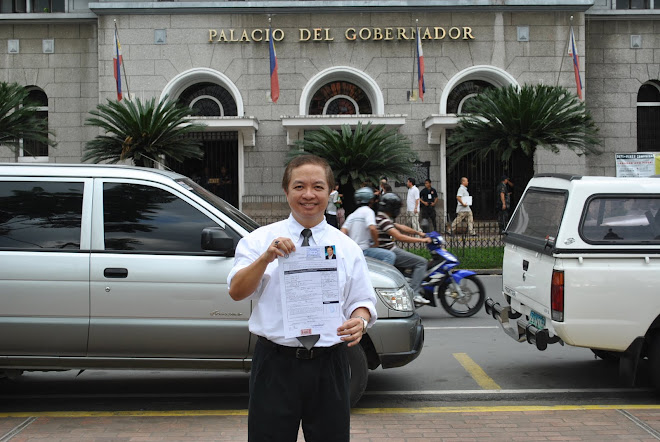Wednesday, March 25, 2009
2 Alabang kids snatched; P1.5M ransom paid
MANILA, Philippines—Two brothers, both high school students, were kidnapped on March 19 and were released five days later upon their parents’ payment of P1.5 million in ransom, according to police sources.
Teresita Ang-See of the Citizens’ Action Against Crime and Corruption (CAACC) Wednesday confirmed the kidnapping, saying it was only one of a series of abductions that suddenly became frequent in the first quarter of the year.
Ang-See said the boys—one studying at the Beacon School and the other at the British School of Manila, both located in Taguig City—were released on Tuesday afternoon. Police sources said the brothers were abducted by armed men while they were on their way to school between 6 and 7 a.m. on Thursday from their residence in Ayala Alabang Village in Muntinlupa City.
The kidnappers were said to have originally demanded ransom of $2 million in the belief that the parents, both currency traders, could afford it.
Pure Filipinos
Ang-See said the kidnappers eventually settled for P1.5 million, after the parents swore that the amount was all the money they could raise in cash at the moment. “The parents tried taking out a bank loan, but practically all their money had gone to the construction of a big house, and the kidnappers wanted cash quick,” Ang-See said. She said she was not able to talk to the family, but added that the brothers were pure Filipinos and not Chinese-Filipinos—the usual targets of kidnapping-for-ransom syndicates. The family did not report the kidnapping to the Police Anti-Crime Emergency Response (PACER), the Philippine National Police’s special anti-kidnapping unit, and personally handled the negotiation for the boys’ release, police sources said.
P24M in 3 months
According to information gathered by the CAACC, there were 17 kidnap victims in January, 20 in February and 12 in March, including the two brothers. All of the victims were released after payment of ransom, and the CAACC monitored more than P24 million paid to various crime syndicates in the last three months. “We are really very bothered that there’s a sudden escalation of kidnapping incidents in the first quarter of this year. In the last two years, there was none. It was quiet. Now the kidnappers are hungry,” Ang-See lamented. She said there was not a single kidnapping case in the last two years, particularly because of the Chinese-Filipino community’s vigilance and continuous cooperation and dialogue with PACER. But according to the PACER chief, Senior Supt. Leonardo Espina, only four kidnapping-for-ransom cases had been reported since January.
Twelve such cases were reported to PACER last year, Espina said. The figure excludes terror-related abduction cases in Mindanao, which the PNP accounts for separately, he said.
“I can say that the situation in the first quarter of 2009 is pretty much the same in 2008 in terms of the situation on kidnapping-for-ransom syndicates ... There are only a few groups now,” Espina said.
Of the four cases, one has been solved. PACER is building up cases against the suspects tagged in the three other incidents and has intensified “coordination with territorial police units where these cases happened,” he said.
Different style
Ang-See said the current modus operandi was to hold the victims for only five to seven days and release them for any amount offered by their families. “Now the kidnappers’ style is different—fast, no protracted negotiation, quick payment of ransom,” she said. The ransom demand is initially high but the actual amount paid ranges from P500,000 or P800,000 to P1 million, Ang-See said. She observed that among the kidnapping cases in Metro Manila and Luzon, the ransom paid for the brothers released on Tuesday was the highest. “Times are hard. The families of kidnap victims can no longer afford to meet big ransom demands,” she said.
Espina made a similar remark, saying the kidnapping trend had developed into smaller-time, quick-money abduction schemes pulled off by maids or even gang members holding children and demanding a release fee of as low as P2,000. “That’s what is increasing the figures. There are many cases not perpetrated by syndicates but by maids, relatives, friends and the like out to make money from their friends or relatives,” he said. Ang-See said that with the similar modus operandi in the cases monitored by the CAACC, the kidnappings could have been pulled off by just one group.
Admit the problem
She said she was not discounting the possibility that this group was being protected by corrupt police and military personnel, whether active or retired. Citing earlier arrests made by PACER, Ang-See said former police and military officers were behind kidnapping-for-ransom activities. She said that in one such case, an active member of the PNP Special Action Force was among those arrested.
But Ang-See expressed confidence in the capability of PNP Director General Jesus Verzosa and PACER to identify and arrest the groups behind the sudden escalation of kidnappings, especially in Metro Manila. She said stamping out kidnapping for ransom should start with the first step—“to admit that there is a problem.” With a report from Tarra Quismundo
(Comment: How can we invite investors and tourists to visit our country if our authorities can't even handle kidnappers and corrupt authorities? Sinabi ko na long before that corruption means hardships to our people (including authorities). No amount of pa-pogi points will eradicate these bad elements in our society when we have a weak government with no political will.) Hindi nila masupil and corruption kasi sila corrupt din.
Teresita Ang-See of the Citizens’ Action Against Crime and Corruption (CAACC) Wednesday confirmed the kidnapping, saying it was only one of a series of abductions that suddenly became frequent in the first quarter of the year.
Ang-See said the boys—one studying at the Beacon School and the other at the British School of Manila, both located in Taguig City—were released on Tuesday afternoon. Police sources said the brothers were abducted by armed men while they were on their way to school between 6 and 7 a.m. on Thursday from their residence in Ayala Alabang Village in Muntinlupa City.
The kidnappers were said to have originally demanded ransom of $2 million in the belief that the parents, both currency traders, could afford it.
Pure Filipinos
Ang-See said the kidnappers eventually settled for P1.5 million, after the parents swore that the amount was all the money they could raise in cash at the moment. “The parents tried taking out a bank loan, but practically all their money had gone to the construction of a big house, and the kidnappers wanted cash quick,” Ang-See said. She said she was not able to talk to the family, but added that the brothers were pure Filipinos and not Chinese-Filipinos—the usual targets of kidnapping-for-ransom syndicates. The family did not report the kidnapping to the Police Anti-Crime Emergency Response (PACER), the Philippine National Police’s special anti-kidnapping unit, and personally handled the negotiation for the boys’ release, police sources said.
P24M in 3 months
According to information gathered by the CAACC, there were 17 kidnap victims in January, 20 in February and 12 in March, including the two brothers. All of the victims were released after payment of ransom, and the CAACC monitored more than P24 million paid to various crime syndicates in the last three months. “We are really very bothered that there’s a sudden escalation of kidnapping incidents in the first quarter of this year. In the last two years, there was none. It was quiet. Now the kidnappers are hungry,” Ang-See lamented. She said there was not a single kidnapping case in the last two years, particularly because of the Chinese-Filipino community’s vigilance and continuous cooperation and dialogue with PACER. But according to the PACER chief, Senior Supt. Leonardo Espina, only four kidnapping-for-ransom cases had been reported since January.
Twelve such cases were reported to PACER last year, Espina said. The figure excludes terror-related abduction cases in Mindanao, which the PNP accounts for separately, he said.
“I can say that the situation in the first quarter of 2009 is pretty much the same in 2008 in terms of the situation on kidnapping-for-ransom syndicates ... There are only a few groups now,” Espina said.
Of the four cases, one has been solved. PACER is building up cases against the suspects tagged in the three other incidents and has intensified “coordination with territorial police units where these cases happened,” he said.
Different style
Ang-See said the current modus operandi was to hold the victims for only five to seven days and release them for any amount offered by their families. “Now the kidnappers’ style is different—fast, no protracted negotiation, quick payment of ransom,” she said. The ransom demand is initially high but the actual amount paid ranges from P500,000 or P800,000 to P1 million, Ang-See said. She observed that among the kidnapping cases in Metro Manila and Luzon, the ransom paid for the brothers released on Tuesday was the highest. “Times are hard. The families of kidnap victims can no longer afford to meet big ransom demands,” she said.
Espina made a similar remark, saying the kidnapping trend had developed into smaller-time, quick-money abduction schemes pulled off by maids or even gang members holding children and demanding a release fee of as low as P2,000. “That’s what is increasing the figures. There are many cases not perpetrated by syndicates but by maids, relatives, friends and the like out to make money from their friends or relatives,” he said. Ang-See said that with the similar modus operandi in the cases monitored by the CAACC, the kidnappings could have been pulled off by just one group.
Admit the problem
She said she was not discounting the possibility that this group was being protected by corrupt police and military personnel, whether active or retired. Citing earlier arrests made by PACER, Ang-See said former police and military officers were behind kidnapping-for-ransom activities. She said that in one such case, an active member of the PNP Special Action Force was among those arrested.
But Ang-See expressed confidence in the capability of PNP Director General Jesus Verzosa and PACER to identify and arrest the groups behind the sudden escalation of kidnappings, especially in Metro Manila. She said stamping out kidnapping for ransom should start with the first step—“to admit that there is a problem.” With a report from Tarra Quismundo
(Comment: How can we invite investors and tourists to visit our country if our authorities can't even handle kidnappers and corrupt authorities? Sinabi ko na long before that corruption means hardships to our people (including authorities). No amount of pa-pogi points will eradicate these bad elements in our society when we have a weak government with no political will.) Hindi nila masupil and corruption kasi sila corrupt din.
Subscribe to:
Post Comments (Atom)










No comments:
Post a Comment